 The results of the election have been extraordinary, and it’s vital to understand how far the radical remaking of the Labour Party from 2015 may have been responsible. Is Labour now a social movement or an electoral force capable of winning an outright majority? Siobhan McAndrew writes it is currently not fully either. She explains why and the implications of the situation for British politics.
The results of the election have been extraordinary, and it’s vital to understand how far the radical remaking of the Labour Party from 2015 may have been responsible. Is Labour now a social movement or an electoral force capable of winning an outright majority? Siobhan McAndrew writes it is currently not fully either. She explains why and the implications of the situation for British politics.
To interpret the unexpected result of the 2017 General Election we need to understand the remaking of the Labour Party. It’s well-known that the £3 Registered Supporter scheme helped elect a leadership candidate unknown to most of the general public from the small Campaign Group of traditional left-wing Labour MPs. It’s less clearly remembered that Corbyn also won a majority among full members. Since then, there have been many anecdotal accounts of long-standing members with more moderate views leaving the party on Corbyn’s election, while membership numbers in total increased, enormously.
The membership’s perception of electoral success is of interest since elite-challenging groups often see power as corrupting. In 2015 and 2016, for example, there was much discussion of the remaking of the Labour Party into a ‘social movement’ where direct participation and building a mass movement matters as much as electoral success. Such participation can provide a sense of belonging and meaning, noted by Yale University political scientist Eitan D. Hersh, and University of Leicester digital media scholar Daniel Allington in his analysis of ‘socialism fans’.
But what do we really know about Labour’s new members? Is the apparent rise of ‘protest Labour’ a generational phenomenon? Or are they simply more left-wing, in line with the post-crash political agenda moving leftwards? Here, I report analysis of survey data on Labour Party members already in the public domain, gathered as part of the British Election Study (BES), which has been running an online panel study via YouGov since February 2014, surveying around 30,000 recurrently. In waves 6 (May 2015), 8 (May-June 2016) and 10 (Nov-Dec 2016, the most recent available) they asked respondents whether they were currently a member of a political party (see endnote [1]).
For each of waves 6, 8 and 10 the numbers reporting Labour membership are over 1000. They allow us to gauge how the temperature of the party as a whole, treating the respondents to each wave as a cross-section.

Figure 1: Party and Leader Affect among Labour Members, BES Waves 6. 8 and 10.
The results surprise slightly because Wave 6 took place after the 2015 election, which Miliband lost; Wave 8 in May-June 2016, before the Brexit result and subsequent leadership challenge; and Wave 10 in November-December 2016 when Corbyn’s position was solidified after the September 2016 leadership election. However, results indicate that liking of both the party and the leader has declined over the period that it has supposedly been remade (see endnote [2]).
It could however be that different types of member were more likely to respond at each time point, so that we’re not comparing like with like over time. To test how the party has changed over time, I restrict analysis to those respondents who completed the survey at each of the three time points. This allows us to contrast long-standing members (members for each wave), new members who joined in Wave 8 or Wave 10, and those who were members in Wave 6 but who left in either Wave 8 or Wave 10 (including those who left and returned). We have 761 cases: 22 per cent are Leavers, 31 per cent Stickers, and 47 per cent New Members.
How do the demographics differ?
The Stickers and Leavers appear more male than New Members, a change also noted by Poletti et al (2016). We might also have expected that New Members were younger, with part of the remaking of the Labour Party ‘generational politics’ at work. But using Ipsos MORI’s definition of social generations, we see that Boomers dominate each of the three groups, forming 59 per cent of Leavers, 60 per cent of New Members and 61 per cent of Stickers. A slightly lower proportion of Leavers are higher-educated, differences are non-significant across the three groups. About half of the sample are in managerial or professional posts; again the differences between the three groups are non-significant. The differences in the proportion other than White also appear non-significant.
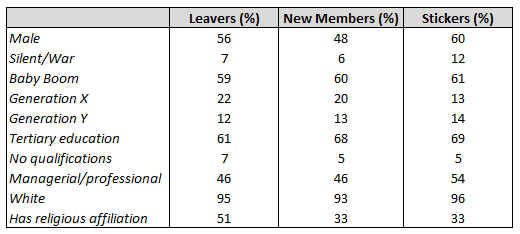
Table 1: Sample of BES respondents responding to each of Wave 6, 8 and 10, and reporting Labour membership on at least one of those waves.
Differences according to whether the respondent reports a religious affiliation or not are significant: 51 per cent of Leavers report an affiliation, compared with 33 per cent each of New Members and Stickers. Given the apparent lack of generational difference, this does not appear to be driven by younger people being more likely to be religious ‘Nones’, but perhaps by a choice to identify with a values-driven political tradition.
We can further test whether the demographic and religious differences hold in a multiple regression model: results are available here. Other than regarding religious affiliation, Leavers and New Members are essentially similar in socio-demographic terms. Stickers are more likely to be male than New Members, more likely to be born before 1945, and more likely to have a middle-class occupation.
Are the new members more left-wing? Are they more liberal? Are they more loyal?
A variety of measures in the BES capture respondents’ basic values on the two primary political dimensions: libertarianism-authoritarianism and the left-right dimension. These are measured by the following batteries of items:
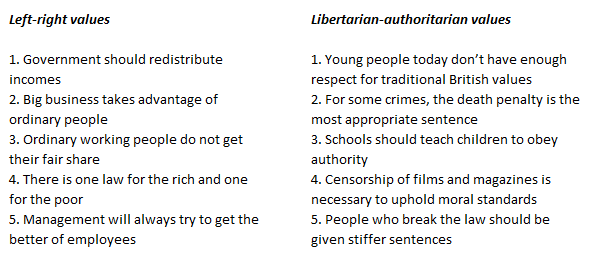
Table 2: Individual items for the left-right and libertarian-authoritarian scales.
The measures have been combined into single left-right and libertarian-authoritarian measures, both of which are reported on a 0–10 scale (0 = most left or libertarian, 10 = most right or authoritarian). Other measures capture respondents’ attitudes towards each of the major parties and the major party leaders: since these are also available on a 0–10 scale, we can subject them to linear regression modelling.
The coefficients for Leavers and New Members compared with Stickers are graphed below (controls for whether the respondent is male or female, social generational terms, educational and occupational terms, partnership status, ethnic minority status and religious affiliation were all included but not presented here). A full-colour bar indicates the difference is significant, while a transparent bar indicates the difference is not significant at the 10 percent level of significance. Further, where the differences are significant, the data label is given in black; if not, it is grey and italicised. The data labels on or adjacent to the bars also report the size of the effect. A label of 1.0 indicates that the relevant group scores one point more highly on average than Stickers on the relevant 0–10 scale, once controls have been taken into account.
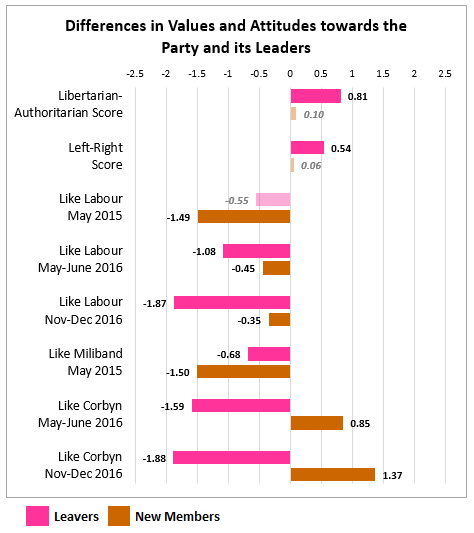
Figure 2: Political Values and Party/Leader Affect among ‘Ever Labour’ Panel responding to BES in each of Waves 6, 8, 10.
What we see is that Leavers are significantly more authoritarian than Stickers, but New Members are not. Leavers are also significantly more right wing, by about half a point; surprisingly, New Members are not more left-wing than Stickers.
In May 2015, at around the time of the 2015 General Election, both Leavers and New Members disliked the Labour Party significantly more than Stickers, with New Members (then not party members) disliking the party more by a point and a half. By May-June 2016, Leavers disliked the party more than Stickers by a point, and New Members by about half that. By winter 2016, the disparity between Leavers and Stickers had grown substantially to almost two points. The New Members were still significantly less warm towards the party than Stickers in winter 2016.
In terms of liking of the leader, New Members disliked Ed Miliband significantly more than Stickers, to the tune of about a point and a half, while Leavers were also less warm. By May 2015, New Members liked Corbyn almost a point more on average than Stickers, once socio-demographic differences were taken to account, and Leavers 1.6 points less. This result is suggestive of their being attracted to Labour by Corbyn rather than the party.
By winter 2016, Leavers liked Corbyn almost two points less and New Members 1.4 points more than Stickers. This suggests a growing divergence of views in the Labour community, and a test of whether the difference grew bigger between New Members and Stickers between wave 8 and wave 10 was confirmed (p < 0.01).
Attitudes to leadership and electoral strategy
The BES includes four items useful here which capture the extent to which respondents prioritise sticking to principles rather than winning power, and attitudes towards political institutions, with respondents asked how far they agree with the following statements.
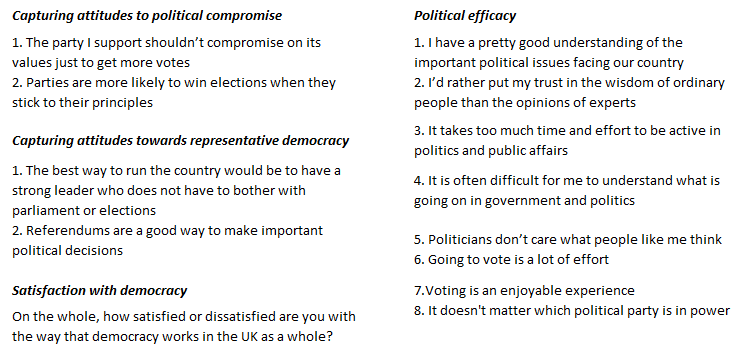
For each of the above, scores range from 1 = strongly disagree to 5 = strongly agree, except for ‘satisfaction with UK democracy’ which is four-step.
I again ran a set of linear regression models and again, the coefficients for Leavers and New Members compared with Stickers (the base) are plotted below (see endnote [3]). As above, these are the predicted effects on agreement with the statement for Leavers compared with Stickers, and New Members compared with Stickers, once demographic controls have been taken into account. We interpret the numbers presented as the increase or decrease in points on the 1–5 scale of being a Leaver or New Member rather than Sticker (or 1–4 for the last item, satisfaction with democracy).
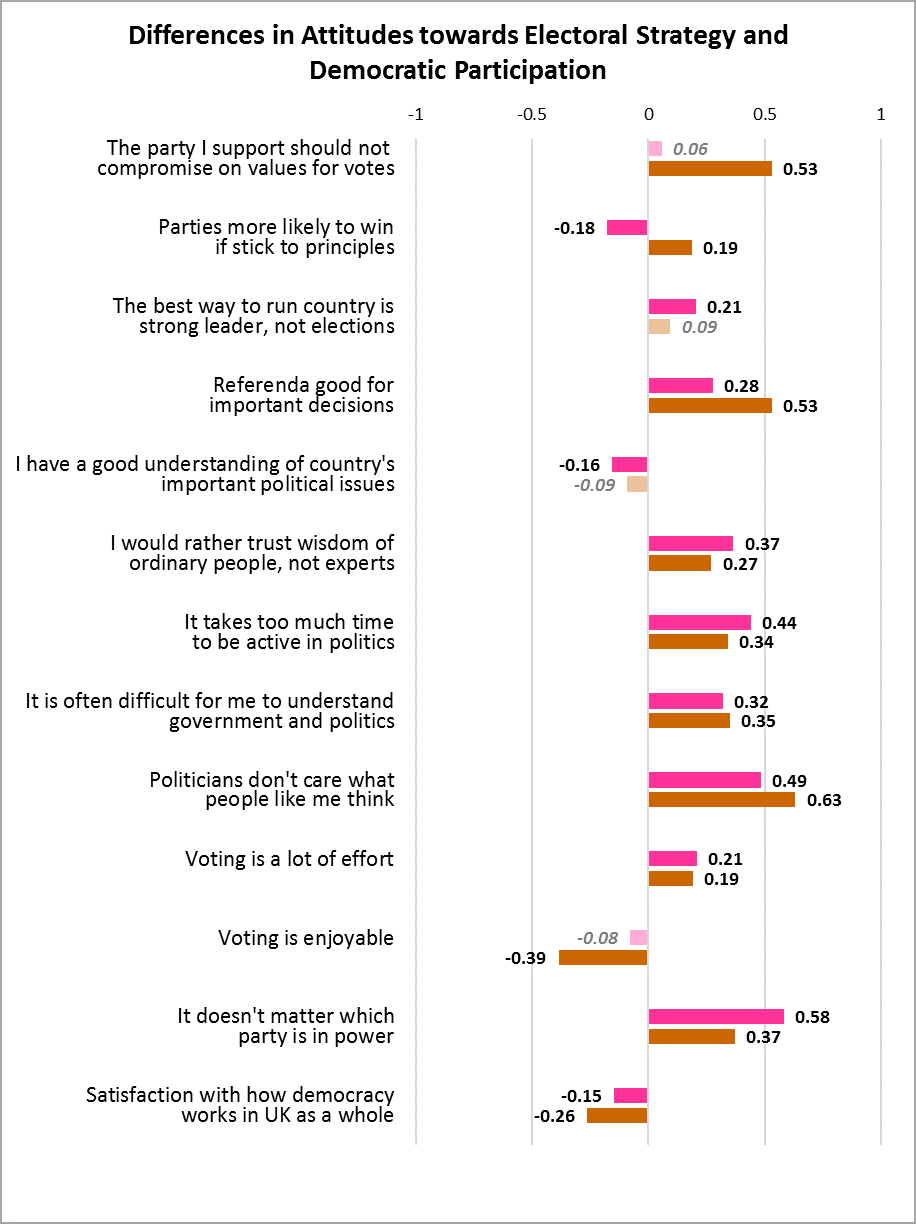
Figure 3: Attitudes towards electoral strategy and democratic efficacy among ‘Ever Labour’ Panel responding to BES in each of Waves 6, 8, and 10.
To summarise, New Members are more keen (to the tune of half a point on a 1–5 scale) not to compromise principles just to get elected. They also believe that parties are more likely to win if they stick to their principles. Leavers have a stronger belief in the need for strong leadership than Stickers, although the difference between Leavers and New Members is not in fact significant. New Members have a much stronger belief in the virtues of direct democracy than Stickers, by over half a point. While Leavers are also more positive towards referenda than Stickers, they are significantly less positive than New Members (p < 0.05).
On self-reported understanding of important political issues, Leavers score significantly less highly than Stickers, while New Members do not; but again, the difference between Leavers and Stickers is not significant. Intriguingly, both Leavers and New Members feel significantly more positive than Stickers towards the wisdom of ordinary people rather than experts , and essentially the same as each other here.
Both groups are more likely than Stickers to agree that active involvement in politics takes ‘too much time’. They also are more likely to agree that it is often difficult to understand what is going on; and that politicians don’t care what ‘people like me’ think. Members of both groups are more likely than Stickers to find going to vote ‘a lot of effort’. For each of these items, again the differences between Leavers and New Members are non-significant. On finding voting an enjoyable experience, Leavers are not significantly different from Stickers, while New Members enjoy voting 0.4 of a point less than Stickers.
Members of both groups score significantly more highly than Stickers on agreeing that it doesn’t matter which party is in power, and here Leavers scored significantly more highly than New Members in Wave 10 (p < 0.05). Members of both groups feel significantly less satisfied with democracy than Stickers; here, the difference between Leavers and New Members is non-significant.
This is intriguing. The two indicators relating to compromise and sticking to principles were originally included on the BES as ‘Corbyn indicators’, and the results are consistent with that. But in terms of general political efficacy, in many respects Leavers and New Members look more like each other than like Stickers, even though in terms of political values New Members and Stickers are more similar.
It is tempting to characterise both groups as only happy to belong to the party when they identify with the leadership. On closer examination, however, it appears that members of both groups have lower political efficacy, and accordingly have weaker ‘pull factors’ to keep them involved when personal gratification is low. The lower enjoyment of voting of the New Members is a clear difference, however.
Are the new members more likely to be denialists? (No)
Some of the most intriguing debate among party members online occurred between those arguing that Corbyn was unpopular in the polls and unelectable, and others arguing either that the polls were flawed or with regard to alternative data. The BES includes seven measures related to ‘active open-mindedness’ which might allow us to examine whether one group rather more than another exhibits ‘motivated reasoning’. These ran on Wave 7, consisting of extent of agreement on a 1–5 scale with statements such as ‘allowing oneself to be convinced by an opposing argument is a sign of good character’; ‘people should take into consideration evidence that goes against their beliefs’; and ‘changing your mind is a sign of weakness’.
These were only put to a subset of the sample, and so numbers are rather small for regression analysis. However we can see how the means differ for each question by type of member, and whether these differences are significant between the three groups. In no case was the difference significant.
Are the new members Left populists? (No)
Could the differences between New Members and earlier members be down to ‘left populism’? The BES included a set of indicators of populism on Wave 7 which help us to investigate further, though as with the ‘active open-mindedness’ measures they were fielded only to a subsection. Respondents were scored on a 1–5 scale, where 1 = strongly disagree and 5= strongly agree, with five statements including ‘the politicians in the UK Parliament need to follow the will of the people’, and ‘the people, and not politicians, should make our most important policy decisions’.
Whether treating the measures as continuous or categorical, differences between the three types of member were non-significant — except where asked whether they ‘would rather be represented by a citizen than by a specialized politician’. Here, New Members were more likely to agree or agree strongly than Leavers or Stickers. For the remaining items, there is no evidence that ‘left populism’ is a salient phenomenon.
Are the new members more engaged online? (Not apparently)
The BES includes some measures of whether the respondent uses Facebook and Twitter. I examined tendency to report ‘yes’ by membership type, again controlling for demographic confounders. Running logistic regressions examining first Twitter use and Facebook use, I found that New Members were significantly less likely to use Twitter than Stickers (p < 0.05) while Leavers were significantly less likely to use Facebook than Stickers (p < 0.1). This doesn’t marry up with the image of newer members being more likely to be keyboard warriors. In terms of how these different types of members actually use Twitter and Facebook, things might well be different.
Finally — are the new members nicer people?
The BES includes measures of the ‘big five’ personality traits: agreeableness, conscientiousness, extraversion, neuroticism, and openness. Looking at all five, there is no evidence of personality differences between Leavers and Stickers, and New Members and Stickers, at conventional levels of significance. Leavers appear to be very slightly more conscientious, and very slightly less open, than New Members, but only at the 10 per cent level of significance. Again, given that the predicted difference is very small indeed, it seems likely that any ‘real’ differences are trivial at best, but more likely non-existent.
Conclusion
The set of analyses above sheds some light on how the British Labour Party has been remade since May 2015. The party membership has not shifted to the left in the sense that new members are more left-wing and have pulled it leftwards. Instead, it has become a narrower church as those who are more centrist have left. It has also become more liberal.
Leavers are characterised by strongly disliking Corbyn, and new members who relatively disliked Miliband as leader and who like Corbyn rather better have more than replaced them. This is suggestive that the leadership matters for recruitment and retention more than generally understood and perhaps before 2015 too.
The long-term strength of Labour’s ‘ground operation’ must partly be down to the pragmatism of the Stickers, whose left-liberal political values are consistent with a greater propensity to viewing winning as important, greater comfort with political knowledge and voting, and greater trust in political efficacy.
Rather than Labour being characterised as either a social movement or an electoral force capable of winning an outright Parliamentary majority, it is currently not fully either. This may change and a further general election in a few months may hasten that. The morale boost of confounding expectations may also change leader and party affect. The results here however suggest an awkward coalition, one which may exemplify a broader de-mainstreaming of British politics.
So, what will follow? Perhaps the different types of member will integrate more strongly, and perhaps they will begin to look more alike in their political values with time. In these times of political turbulence, it’s impossible to say.
_____
Note: this first appeared on Siobhan’s personal blog.
 Siobhan McAndrew is Lecturer in Sociology with Quantitative Research Methods at the University of Bristol. She specialises in the social science of religion and culture.
Siobhan McAndrew is Lecturer in Sociology with Quantitative Research Methods at the University of Bristol. She specialises in the social science of religion and culture.
Notes
[1] Of the Wave 10 respondents, 8 per cent indicated they were currently a member of a political party and 7 per cent that they had been in the past: the BES YouGov sample is highly-engaged.
[2] Note that I work with unweighted data; ideally we would weight the data to party membership profile (and the Labour Party presumably has good measures of membership demographics). In their absence, weighting by BES survey weights makes little sense and the results are essentially the same either way. It may well be difficult to generalise to the entire membership since this is likely to be a highly engaged, online group. Nevertheless, it provides the opportunity to say something beyond anecdote. This is a non-random sample, and yet it seems unlikely that the less-engaged, or the active-offline membership would feel much warmer to the party and Corbyn over time.
[3] Strictly, ordinal logistic regression should be used, but linear regression yields coefficients which are simpler to interpret and report.







